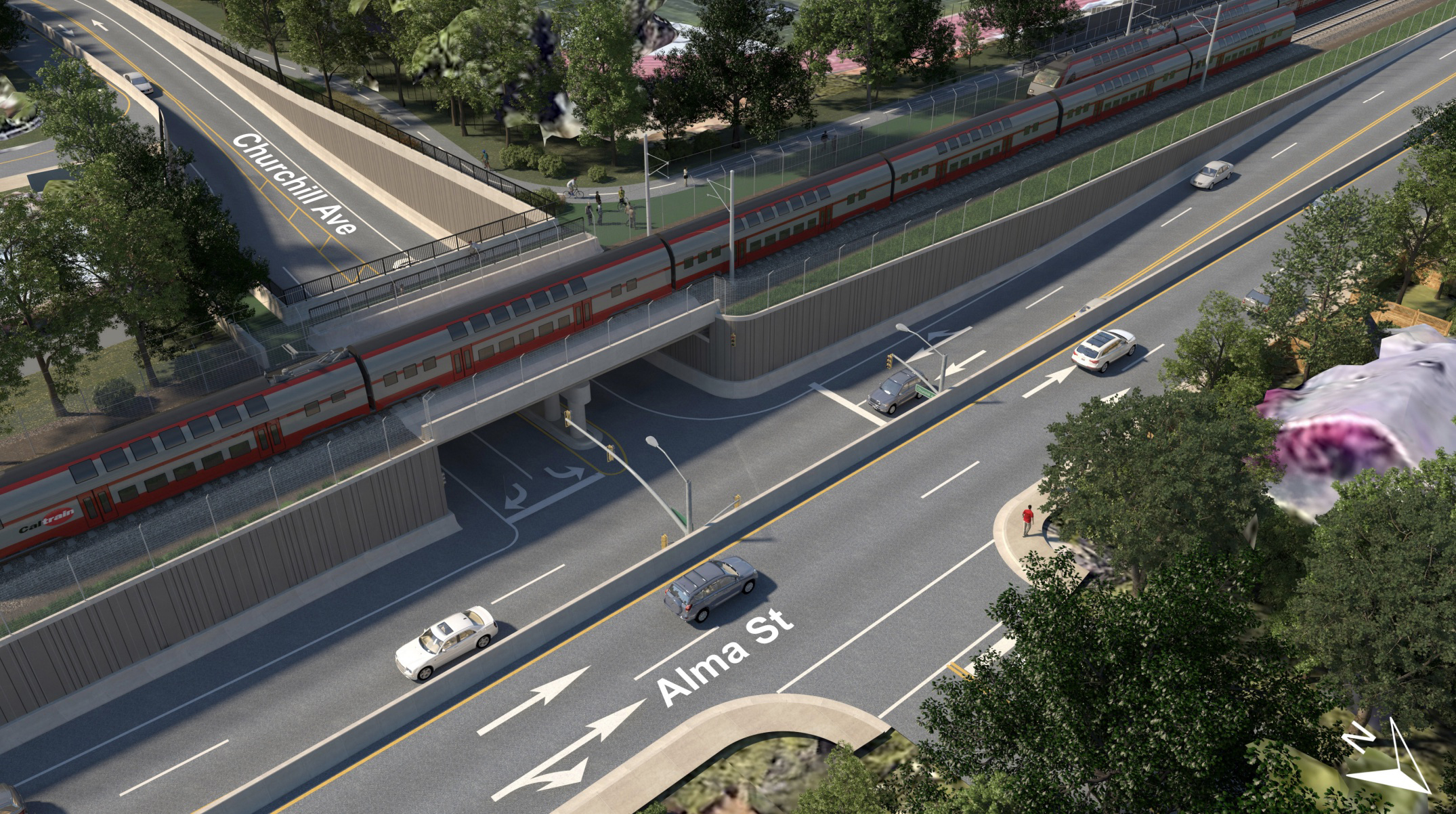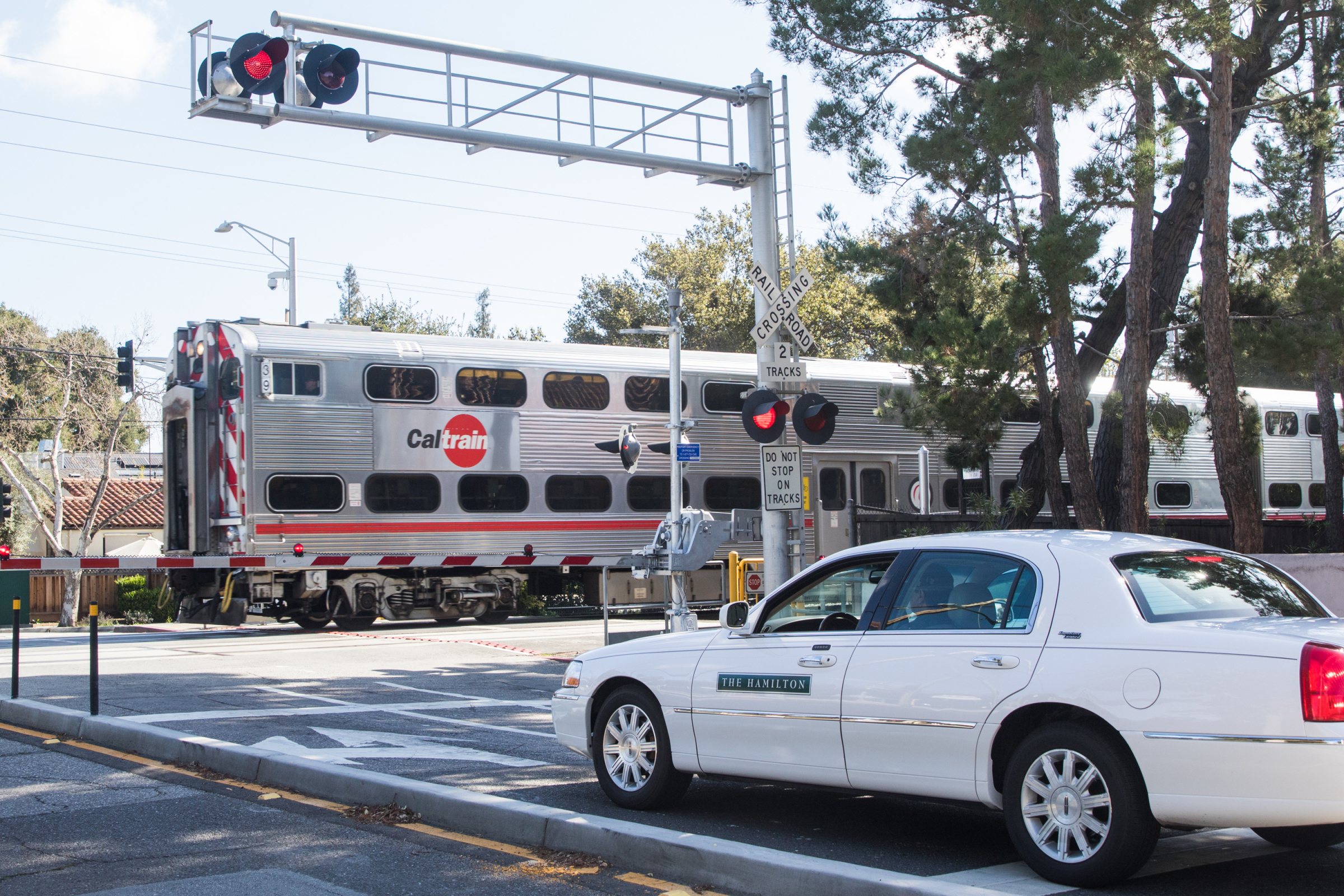When the Metropolitan Transportation Commission (MTC) board of directors met last month to approve a list of rail projects to endorse for federal grants under the Bipartisan Infrastructure Law, one Peninsula city was conspicuously left out.
Palo Alto, which has been planning for nearly a decade to redesign its four rail crossings so that they no longer intersect with roads, did not get any of its projects on the regional agency's list. By contrast, Mountain View and Sunnyvale, the other two Santa Clara County cities that are also eligible for grade-separation funds under a 2016 county tax measure, each saw their projects on the regional list.
The commission's decision was based in large part on how close the projects are to actually getting built. In that sense Mountain View, which is looking to close Castro Street to traffic and to lower Rengstorff Avenue underneath the train tracks, is well ahead of the competition. Both of its projects made the MTC list, an inclusion that was celebrated by council member Margaret Abe-Koga, who sits on the MTC board of directors.
"We are ready to go on our projects," Abe-Koga said at the March 23 meeting.
Sunnyvale, which is a bit behind Mountain View, is currently evaluating its options for its two crossings at Mary and Sunnyvale avenues. A feasibility study that the city is now pursuing is considering two options for each crossing, all of which entail an undercrossing under the railroad tracks. Its Mary Avenue project made the MTC list of projects that are endorsed for federal funds.
But Palo Alto, which has four at-grade crossings, remains very much undecided about the future of its rail corridor despite years of hearings and millions of dollars spent on analysis. The council has halted discussion of the northernmost crossing, at Palo Alto Avenue, which members hope to evaluate at some point in the future as part of a broader downtown plan. In the south end of the city, the city is planning for grade separations at the Meadow Drive and Charleston Road crossings, long deemed to be the most dangerous and urgently in need of a redesign. The city is still weighing three options: a trench, an underpass for cars and bicyclists, and a "hybrid" design that combines raising tracks and lowering roads.
The Churchill Avenue crossing is somewhat further along, with the council throwing its support last November behind a vehicle underpass option that was designed by Southgate resident Mike Price, who lives close to the crossing. Even here, however, council members acknowledged that this relatively new alternative would require far more analysis before any work could proceed.
As the MTC's decision demonstrated, Palo Alto's lengthy decision-making process has made it difficult for the city to apply for regional and federal funds. That point was further underscored by Carolyn Gonot, general manager and chief executive officer of the Santa Clara Valley Transportation Authority (VTA), the agency that in 2016 passed Measure B, a sales tax increase that devotes $700 million to grade separation projects in Mountain View, Sunnyvale and Palo Alto. On April 20, Gonot gave a presentation to Palo Alto's newly reconstituted Rail Committee in which she updated council members and community advocates about the process for distributing funding.
"You really want to get your projects shelf ready — and you know that — through delivery," Gonot said. "Oftentimes, the ability to get them ready is really critical for us because much of the time it really is about how fast there can be a ribbon-cutting and those kinds of things."
Yet Palo Alto's outlook on funding is not entirely bleak. Last year, the city struck a deal with Mountain View and Sunnyvale that would provide Palo Alto with half of the Measure B funding, or about $350 million. And earlier this week, the Palo Alto council agreed that the city's proposed business tax, which voters will consider in November, should be used in part to fund grade separations.
Mayor Pat Burt, who serves on the Rail Committee, said Monday that the local funds can be leveraged to apply for federal and state grants down the road.
"We now have significant federal dollars coming in to grade separation funding and modest state dollars that are likely to increase in the next year or two, and we're likely to have regional measures," Burt said during the council discussion. "Almost invariably, these kinds of projects are funded over time after the design is selected and different funding sources are assembled to address them."
These sources, however, generally require a local share, which could come from the business tax.
"If we don't have that, we don't get out of the gate, that's the problem," Burt said.
Waiting on Caltrain
Palo Alto's progress on making a final decision about preferred grade-separation alternatives has also been hampered by Caltrain, which is forging ahead with electrification of its rail system and has been preparing for a corridor-wide study of grade separation. Once completed, the study will inform the city's decision-makers on key questions such as construction techniques and the feasibility of developing alternatives that require steeper grades on the tracks. Caltrain generally allows a 1% grade, though the city hopes that the agency would approve a 2% grade for the options that require lower or raising tracks.
While Caltrain's study has been delayed by the pandemic, the agency is now once again getting ready to launch it, the agency's acting Executive Director Michelle Bouchard told the Rail Committee on April 20.
"We're just now kick-starting the technical part of that study that will help to firm up standards and that will help any community that wants to pursue initial design work to look at alternatives," Bouchard said.
Burt suggested that part of the reason why it's taking the city so long to pick its preferred alternatives is the complexity of its section of the Caltrain corridor.
"We are amongst if not the most constrained corridor in the system between San Jose and San Francisco, which makes all of our design issues more difficult, with both the width of the corridor being narrow and development on either side of the corridor limiting our possibilities," Burt said. "That's what accentuates our challenges."
Costs aside, just about every crossing has its own peculiar challenges. Digging a trench in south Palo Alto for the Meadow and Charleston crossings would require the city to reroute Barron and Adobe creeks. On the north end, Palo Alto would have to make sure that whatever design it chooses steers clear of both San Francisquito Creek and El Palo Alto, the city's iconic namesake redwood that stands near the rail crossing.
There's also the thorny issue of community consensus. In picking an underpass alternative for the Churchill crossing last year, the council found itself facing a significant split among nearby residents, with some calling for full closure of Churchill to traffic and others advocating for a viaduct or an underpass. The majority of the Expanded Community Advisory Committee, a task force that the council appointed to vet the various alternatives, recommended closure, the cheapest and simplest option on the table. The council instead chose the underpass.
With Caltrain launching work on its corridor-wide study and the city moving ahead with its own suite of analyses of the various alternatives, neither the Rail Committee nor community advocates were overly concerned about being left off the MTC list. By waiting until Caltrain releases its new design standards and its analysis of construction techniques, Palo Alto will be better equipped to make the right decision on grade separation.
Elizabeth Alexis, a longtime advocate for grade separations and a member of the watchdog group Californians Advocating for Responsible Rail Design, urged Caltrain to move ahead with this work so that cities like Palo Alto won't have to seek design exceptions from the rail agency for their grade separation projects.
"Because of the desire to get to ribbon cutting, sometimes (cities) decide they're not going to fight those battles and it's easier just to get another $15 million to get a more expensive, overbuilt project," Alexis said. "But I'd really like to find some way … to really front-load that work, instead of there being exceptions."




Comments
Registered user
another community
on Apr 29, 2022 at 12:58 pm
Registered user
on Apr 29, 2022 at 12:58 pm
As a resident of Menlo Park, which has been as slow as Palo Alto in moving forward on rail separations, I'm in envy of Mountain View and Sunnyvale. My community seems intent on coming up with a magical plan that will satisfy all groups, simultaneously. That's impossible to do. Seems like we just restudy and restudy and restudy the proposals. We can lay all of the planners and their studies down on the ground, end-to-end—but, alas, they never reach a conclusion.
Registered user
Willowgate
on May 2, 2022 at 3:00 pm
Registered user
on May 2, 2022 at 3:00 pm
Where are the people who wanted Elon Musk to bore a tunnel for the Palo Alto grade separations? Surely there are some influential Palo Altans who can reach out on twitter to get him to say he’ll solve all our problems. He’s sold tunnels to Brockway, Ogdenville, and North Haverbrook, and it put them on the map. There's nothing on Earth like a genuine bona-fide Elon Muskified tunnel.